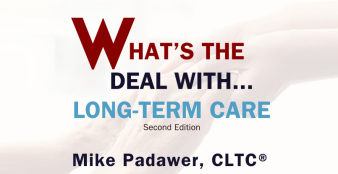DON'T GO IT ALONE: Why Self-Insuring Is A Poor Choice For Long-Term Care Planning Today
For many Americans, self-insuring for potential Long-Term Care needs has been the most prevalent planning method. However, while many people feel they can afford to “go it alone”, the real questions is why would they?
Quite simply, Self-Insuring potential Long-Term Care assumes an unlimited level of risk, and this is counterintuitive to the prudent approach which allows most people to generate their wealth in the first place!! When determining whether or not to implement a Long-Term Care plan, we recommend you and/or the clients you advise seriously consider the topics below.....
Managing Expenses is NOT the same as Managing Care
Even though they may be able to accept the financial burden in the event of a Long-Term Care need, most Americans will not have someone to manage, monitor and adjust a plan of care with their physicians and caregivers. In fact, a properly implemented Long-Term Care plan provides access to independent healthcare professionals who will help assess needs, negotiate provider discounts and coordinate the best plan of care moving forward.
This can be a valuable benefit; especially for those who want to guarantee the best care possible' while minimizing the emotional and physical impact on a spouse or family members.
Asset Allocation Models
For many, the best course of action for Long-Term Care planning may be to reposition a portion of their assets to address the situation. There are a number of very effective ways to do so with existing life insurance, annuities, investments or savings. These options will usually (1) have ZERO downside market risk, (2) complete guarantee of principal and (3) provide a substantial leveraged benefit to mitigate the risk associated with future Long Term Care needs.
Most people are surprised to learn that their Long-Term Care plan can often be implemented with absolutely no out of pocket costs or ongoing expense.
Liquidity Concerns
Just because someone has the intention to self-insure their Long-Term Care needs, most lack the the required liquidity to do so. It’s very important to look at the source of their assets. Business owners or those with a significant amount of their net-worth in retirement accounts should recognize that liquidity can be a big problem.
A lack of liquidity may force the sale of a business at a highly discounted rate, or necessitate the liquidation of retirement accounts at an inopportune time; such as a market downturn. In additional to the liquidity issue, there’s the very real possibility of facing unwarranted and substantial tax liabilities associated with these events.
Asset Protection
Most Americans understand risk management and the use of leverage, so it may be preferable to consider implementing a Long-Term Care plan which “protects dollars with pennies” to provide a significant level of asset protection. Today's Asset-Based Long-Term Care solutions do just that!!
Many Americans are unaware that Asset-Based solutions overcome the biggest objections to traditional Long-Term Care insurance: Cost Certainty & Lack of Residual Value.
Additionally, these are effective solutions which are feature-rich and offer significant benefits by creating a basic pool of funds to cover future Long-Term Care expenses. In the event Long-Term Care is not required, those assets return to their estate for distribution to heirs.
Limiting Potential Liability
If Long-Term Care is viewed as a potential liability, then it’s important to recognize how to manage this liability. Consider a family or individual who could afford to bear the financial risk of an incident in their home or some other large loss. Even so, under such a scenario most people wouldn't cancel their Home Owners insurance as this would leave them vulnerable to potential liability above and beyond even their own comfort level.
With a 70% change of experiencing a Long-Term Care need durings one's life, protecting against the liabilities associated with such a need is simply a prudent measure.
Leveraging Existing Estate Planning Tools
Many people take steps to protect their estate or create a legacy, and while they address their situations in a variety of ways, often an Irrevocable Life Insurance Trust (ILIT) is included as part of the plan. When life insurance is owned by an ILIT, the death benefits are not inside the grantor’s estate upon death, so those proceeds can be used to create a legacy or pay estate taxes.....Most people don’t realize an ILIT can be used to implement a Long-Term Care plan as well. Assuming the proper solution is included in the ILIT, this is a very attractive way to implement a Long-Term Care plan and take advantage of existing tax laws in the process.
A Long-Term Care plan is a wealth management tool.....
One I strongly recommend you and/or your family consider.


